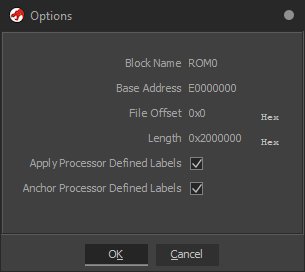This is an old revision of the document!
Table of Contents
Create a Ghidra project
Scope of this section is not to explain how to use Ghidra, but how to create a project based on pre-made ROM dump.
As time of writing, this guide can be applied to Digic 6,7,8,X models running EOS firmware variant. This includes some non-EOS cameras (like PowerShot SX740 HS) and excludes some EOS ones (eg M10) which run PowerShot firmware variant. For later, refer to CHDK Wiki.
Preparation
What you need:
- ROM dumps (see: Obtaining ROM dumps)
- Ghidra installation
Loading main ROM image into Ghidra
First, select the file that contains actual code. On Digic 6 cameras there's only “ROM1.bin”, Digic 7, 8 and X models use ROM0.bin and (in most cases) ROM1.bin, where ROM0.bin contains the code.
Simply drag and drop ROM file into a project window. Import dialog will pop up.
Following settings are required:
Language: For Digic 6 and up select ARM, v7, little endian, default compiler
Options: In this dialog we define at what memory address image will be loaded.
- Block name: as you wish, but something meaningful is recommended (eg ROM0, ROM1)
- Base Address:
- Digic 6: ROM1 loads at
0xFE000000 - Digic 7,8,x: ROM0 loads at
0xE0000000
- Leave all other options as default.
Close by clicking OK on all dialogs, and then acknowledge the import result. File will appear in a project.
Initial analysis
Click twice on newly imported file. It will bring up “Code Browser” window.
Ghidra will ask if you want to perform auto analysis now - select No.
Fix memory map
Navigate to Window → Memory Map. In the only existing row (representing loaded ROM image) uncheck tick in “W” (writable) column. This may affect analysis, and affects decompiler results.
Run disassembly
Jump to second level (DryOS) bootloader address (press 'G' in Listing window):
| CPU | Address |
|---|---|
| Digic 6 | 0xFE0A0000 |
| Digic 7,8 | 0xE0040000 |
| Digic X | 0xE0100000 |
Press F12 to disassemble in Thumb mode. Wait for Ghidra to finish a task - it will discover a lot of functions so it will take some time.
After it is done, we name that function firmware_entry
Run auto analysis
Navigate to Analysis → Auto analysis “<file_name>”.
There's no good answer on what should be selected here (some tools may even crash Ghidra), but as a rule of thumb:
- Disable “Non-returning functions - discovered”
- Disable “Embedded Media”.
- Disable “Create Address Tables”. In worst cases this option exhausts system memory and crashes Ghidra.
Run the analysis - it will take a long time. After it is done, you may want to run “one shot” analysis for Embedded media and for Create Address Tables - but YMMV.


